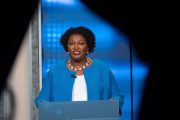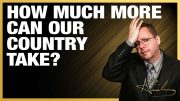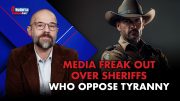
With all the “conservatives” around, it’s no wonder that marriage is universally considered one man and one woman, the trans agenda has been soundly rejected, sexual propriety is de rigueur, and the border is secure.
Oh, wait…
Regardless of our cultural drift, a Gallup survey does tell us that the number of states where liberals outnumber conservatives has dropped from nine to six.
“The residents of most U.S. states are more likely to identify as conservative than as liberal in their political ideology,” Gallup reports. “In 25 states, the conservative advantage is significantly greater than the national average, including 19 ‘highly conservative’ states in which conservatives outnumber liberals by at least 20 percentage points. Meanwhile, in six states, there are more liberals than conservatives.”
“Nationally, the conservative advantage in ideological identification is nine percentage points,” the site continues.
Then there are the M&M bookends. Gallup found that the most “conservative” state is Mississippi, where 50 percent of the residents embrace that label; 12 percent say they’re liberal; 29 percent call themselves moderate; and nine percent, as with another confused group, didn’t know how to identify (okay, technically, they had “no opinion”).
Massachusetts is the most liberal state, with only 21 percent of respondents calling themselves conservative, 35 percent embracing the liberal label, 38 percent saying they’re moderate, and six percent having no opinion.
The other five states where liberals predominate are New York, Vermont, New Hampshire, Washington, and Hawaii. Counterintuitively, though California has been dubbed the “Land of Fruits and Nuts,” liberals and conservatives were actually equally represented there at 29 percent each.
So if the United States is so “conservative,” why does the nation continually drift left? How is it that the Democrats swept the House in 2018?
Well, to add perspective, note that conservatives’ current nine-point national advantage reflects a whopping “narrowing of the conservative-liberal gap from 21 points in 2004,” Gallup also informs.
As for the decline in liberal-dominant states from nine to six, Gallup tells us that many “of the changes are within the margin of error for the state’s sample — states that barely tilted liberal in 2017 barely tilted conservative in 2018 — so it is unclear how meaningful these changes are.”
Yet even this doesn’t truly tell the tale. Question: How is it that California is a Democrat bastion despite the even lib-con split and that Illinois, Maine, Oregon, Connecticut, Colorado, Delaware, Nevada, New Mexico, New Jersey, and Rhode Island are under complete Democrat control despite having “more conservatives than liberals”?
Some might explain this by way of vote fraud, which certainly occurs. Yet there are far more significant factors, one of which is that most moderates, well, aren’t.
A plurality of most of these states’ residents claims to be “moderate” — making them the most formidable voting bloc — but the reality is that an inordinate percentage of moderates are liberals.
First, liberals tend to be solipsistic, bubble-blinded-and-immersed people who mistake their views as centrist. (There was such a fellow who used to comment at my website; he never took anything but a hard-left position but claimed “moderate” status.) The “bubble” I mentioned, which exacerbates this problem, refers to liberals’ tendency to get information from only pseudo-elite sources, which are left-wing; examples are media outlets such as the New York Times and CNN and studies disgorged by left-wing universities. Thus can they very well come to believe that relatively uncommon views are common — because they’re common among the pseudo-elites.
Moreover, liberals are very image oriented and thus often don’t like seeming radical. So they may have an emotional/psychological vested interest in convincing themselves and others that they’re just middle-of-the-road “voices of reason.”
Yet an even deeper explanation here relates to a little understood fact: The terms “liberal” and “conservative” have only relative definitions, changing from time to time and place to place. As I explained in 2008:
Some “conservatives” embrace an ideology prescribing limited government — one remaining within the boundaries established by the Constitution — and low taxation. They favor nationalism over internationalism; prefer markets mostly unfettered by regulation; eschew multiculturalism, feminism and radical environmentalism; and take pride in our history and traditions.
But there have been other kinds of conservatives. In the Soviet Union, a conservative was quite the opposite, a communist. Then, when Dutch politician Pim Fortuyn was assassinated in 2002, BBC News ran the headline, “Dutch far-right leader shot dead.” “Far-right” indeed. Fortuyn was quite liberal by our standards; he was a pro-abortion, openly-homosexual ex-sociology professor branded a rightist mainly because he wished to stem Moslem immigration into Holland. Moreover, his fear was that zealous Moslems posed a threat to the nation’s liberal social structure.
Note, too, that a “liberal” in the Soviet Union and an American “conservative” were both the same thing in the 1970s: anti-communist.
The explanation is that the only consistent definitions of “conservative” and “liberal” are respectively, “prescribing maintenance of the status quo” and “prescribing change of the status quo.” Thus, times and places with different status quos — different “centers” — will have different conceptions of what these political terms represent.
What this means is that “conservatism” and “liberalism” are not ideologies but processes.
Conservatism is the process of ever trying to “conserve” what “is.”
Liberalism is the process of ever trying to change what “is.”
The point? Gallup’s respondents were self-identifying — and, as a certain bizarre sexual-devolutionary agenda well illustrates today, we know how meaningful this is.
In other words, many people call themselves conservatives, but do they reflect 1940s American conservatives, who opposed Social Security (SS) and cohabitation and were far more robustly Christian?
In fact, many conservatives now accept, or are at least tolerant of, things only liberals once pushed. Examples are the aforementioned SS, homosexual behavior, vulgarity, decadent entertainment, women in the military and on police forces, and school sex education; and conservatives increasingly support same-sex “marriage” and even, a poll shows, Medicare for All.
This is no surprise. Conservatives are status-quo defenders, and today’s status quo was shaped by yesterday’s change agents: liberals.
This is why philosopher G.K. Chesterton once noted that the “business of Progressives is to go on making mistakes. The business of the Conservatives is to prevent the mistakes from being corrected.” We’d do well to reconsider defining ourselves based on the conservative-liberal model and to remember that there is only Truth — which is unchanging — and everything else.
And though sometimes fashionable, everything else is a lie.
Photo: PeopleImages / E+



